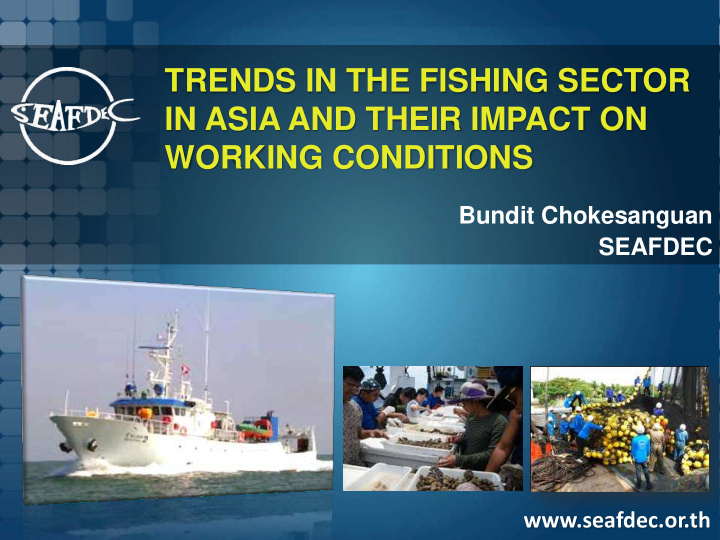



TRENDS IN THE FISHING SECTOR IN ASIA AND THEIR IMPACT ON WORKING CONDITIONS Bundit Chokesanguan SEAFDEC www.seafdec.or.th
INTRODUCTION OF SEAFDEC 11 Member Countries SEAFDEC Offices Brunei Myanmar Darussalam Cambodia Philippines Secretariat Indonesia Singapore Thailand Japan TD: 1968 MFRD: 1969 Vietnam Laos Malaysia AQD: 1973 MFRDMD: 1992
THE PROGRAM OF WORK OF THE TRAINING DEPARTMENT Research and Development Program - Sustainable Capture Fisheries - Optimum Utilization of Fishery Resources - Resource Enhancement - Resilience of Fishing Communities - Emerging Issues Training Program - International & Regional Training - Local Training - Tailor-made Training Information Program - Information & Training packages - Promotion Material, Magazine, Newsletter, etc.
FISH CONSUMPTION Changing share of developing countries in fish consumption, 1973 and 1997 Source: Calculated by authors from FAO statistical databases (accessed January 2002)
FISH PRODUCTION Changing share of developing countries in the production of fish for food, 1973 and 1997 Source: Calculated by authors from FAO, Fishstat Plus: Universal Software for Fishery Statistical Time Series (Rome: FAO Fisheries Department, Fishery Information, Data and Statistics Unit, 2002)
TRENDS OF FISHERY PRODUCTIONS IN SOUTHEAST ASIA
NUMBER OF FISHING VESSELS IN SOUTHEAST ASIA 2011 Country Less than 24 meters Remarks Total 24 meters and over Brunei 2,480 2,476 4 Darussalam Cambodia 7,034 7,034 0 Indonesia 570,827 569,105 1,722 24 meters and over consist of 1367 fishing vessels, 355 fish carriers Lao PDR 1,615 1,615 0 Fiber and wooden boats in Namtheun 2 Reservoir only Malaysia 49,756 49,673 83 Myanmar 28,357 27,000 1,357 Philippines 473,400 472,804 > 596 (data covers 5,869 (data cover 150 GT and from 3.1 to 149.99 over) GT) Thailand 33,915 33,050 865 Data for 2012 Vietnam 128,000 127,700 ~300 Data for 2012
MAJOR FISHING GEARS AND NO.FISHERS
MOVIES Trawl Purse Seine Longline Fish Landing
TRENDS • Decreasing Fisheries and Marine Biodiversity – Over exploitation of many species, destructive fishing practices and habitat losses are main causes of declining levels of biodiversity in marine environments • Resource Declines and Over Capacities – Total catches of marine fish continue to flatten, as most major fishing areas are either fully exploited or over exploited – Based on current trends, production from capture fisheries in the Asian Region will decline over the next ten to twenty years • Habitat and Environmental Degradation – Habitat and Environmental Degradation is having negative • Property Rights and Conflicts
ISSUES AND IMPACT • TOWARD AEC (ASEAN Economic Community) • CLIMATE CHANGE • FUEL AND ENERGY OPTIMIZATION • IUU FISHING: – PSM – Global & Regional Fishing Vessel Record – MCS • OTHER INTERNATIONAL ISSUES
TOWARD ASEAN ECONOMIC COMMUNITY Refers to ASEAN Economic Community (AEC) Blueprint • The ASEAN Leaders adopted the ASEAN Economic Blueprint at the 13th ASEAN Summit on 20 November 2007 in Singapore to serve as a coherent master plan guiding the establishment of the ASEAN Economic Community 2015. • Next up in the AEC is the liberalization of trade in services, investment, labor mobility, and greater harmonization of rules and regulations. Liberalization of trade in goods under AFTA was completed in 2010. The AEC also makes the usual calls for greater economic cooperation in such areas as SME networking and joint research.
CLIMATE CHANGE • Climate changes in temperature has become an important new threat to production of fisheries. (aquaculture and Fish stocks) • Storms more frequent and extreme (fishery infrastructure)
FUEL AND ENERGY OPTIMIZATION • The cost of fossil fuels will become a more critical factor for fisheries in the coming decades. • Marine capture fisheries are acknowledged to be the most energy intensive food production method in the world • CO 2 emissions and carbon foot print will be raised for reductions in fishery activities
IUU FISHING AND MEASURES Port State Measures (PSM) • Ports are the most convenient control point • Port controls aim to take away economic incentives to fish and trade in fish illegally – deny access to port – report illegal activity to RFMO / flag country / other countries – take relevant actions (e.g. Impound vessels or catch) • Port controls apply to foreign vessels: – fishing vessels – fish carrier vessels – transhipment vessels – servicing vessels • Mainly aimed at controlling illegal fishing of stocks covered by RFMOs – E.g. tuna (IOTC, WCPFC) – Toothfish (CCAMLR) • Support the EU-IUU regulation (for fish landed by foreign vessels) • Also help combat other illegal activity: – Trafficking, drugs, weapons, contraband, smuggling
IUU FISHING AND MEASURES Regional Fishing Vessel Record (RFVR) Name of vessel Type of fishing Port of registry method/gear Gross tonnage (G.T.) Length (L) Breadth (B) Depth (D) Engine Power Shipyard Date of launching International Radio Engine Brand Call Sign Serial number of Hull material Date of registration engine Area (country) of Nationality of vessel Previous name (if fishing operation (flag) any) Previous flag (if any) Name of captain/ Nationality of master captain/master Number of crew Nationality of crew (maximum/minimum)
IUU FISHING AND MEASURES Monitoring, Control and Surveillances (MCS) M information gathering, analysis, planning, consultation, decision- making S C allocation of resources checking and supervision and regulations or of fishing and related rules formulation and activities and with implementation enforcement as necessary
CHANGLLENGE AND OPPORTUNITIES - Vessels standards will be improved to meet IMO, ILO, FAO and other International Standards - Fishing operations and activities will be responsible and meet standard - Crews & Fishers will be trained & to better understand upgrade to meet the standards & Certificate
FUTURE WORK & IMPLEMENTATION Safety FAO/ILO/IMO Code of Safety Voluntary Decent Working Recommendations Document for for Fishermen Guidelines for Conditions Safety for Decked Fishing Guidance on and Fishing the Design, and Social Vessels 2005 Vessels of Less than Training and Construction Protection (Work in 12 metres in Length Certification of and Equipment Fishing Convention and Undecked Fishing Vessel of Small Fishing No.188 Fishing Vessels Personnel Vessels 2005 Recommendation No.199)
THANK YOU
Recommend
More recommend